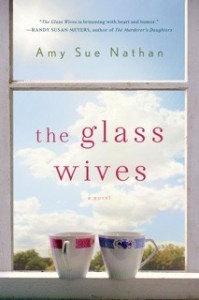The Glass Wives: An Interview with Amy Sue Nathan, Literary Mama
The Glass Wives
St. Martin’s Griffin, 2013
I first met Amy Sue Nathan in an online memoir workshop in 2007. Nathan was trying to write down the bones of recent and tragic events. In 2002, with two young children, Nathan’s marriage broke up. Just two years later, her ex-husband died unexpectedly, by then having fathered a third child with his second wife. Nathan soon discovered that her story was too sensitive and personal to publish as a memoir. Slowly, like sediment forming a fossil, she replaced details of her real-life story with fictional details, yet kept the basic imprint: Both Nathan and her fictional character The Glass Wives share a driving concern, guiding twice-traumatized children through life-shattering events.
In The Glass Wives, Nathan’s debut novel, Evie Glass finds her ex-husband’s new wife, Nicole, on her doorstep with packed bags and an infant son. This second Mrs. Glass has decided that the Glass wives should deal with their husband’s sudden death together: share a roof, some finances, and babysitting while the estate settles and the smoke of their lives clears. Evie, mother of twins Sam and Sophie, doesn’t like her replacement’s low slung jeans, her tattoo, or her size two figure. She doesn’t like how Nicole imposes Christmas tinsel and Hallmark sentiment on the household without regard for the twins’ Jewish heritage. Yet one thing binds the two women irrevocably: motherhood. Both Glass wives are devoted to their own children and also love each other’s, the offspring of their common husband, Richard. “The great equalizer,” Nathan writes. “Mothers could unite over spit-up and night terrors or cherub cheeks and teething woes, no matter the situation.”
The novel explores how Evie and, indirectly, Nathan, came to befriend the second wife, how they learned to stick together for the sake of the children. “The best way to heal the gaping wound in Sam’s and Sophie’s hearts was to keep Nicole and Luca in their lives,” Evie says, but quickly adds that “a woman had to have boundaries.” Indeed, Evie’s boundaries are tested repeatedly throughout the novel. During the four month period in which Evie tries to take her children from “a volcano of grief” into something approximating normal, she faces the judgment, platitudes, speculations, and morbid curiosity of friends and neighbors. When Evie learns of Nicole’s tragic past, however, she realizes that she too has judged harshly.
Such a sad story might have sunk under its own weight, drowned in sentimentality. But The Glass Wives takes a solemn subject and gives it a light but deep touch. The book’s real connective tissue is the day-to-day texture of parenting. “During her marriage, Evie had known the kids were crying before Richard ever heard a sound.” Evie’s maternal instincts were “the flip that switched when the twins were born.” Yet after the divorce, when Evie shared custody, she’d been able to turn off “her sixth, seventh, and eighth senses every other weekend.”
I recently spoke with Amy Sue Nathan about motherhood, writing, and the process of creating The Glass Wives as a work of fiction. “I realized there was a story that was bigger than one family in one house in one town,” Nathan says. “I didn’t have to write about what happened to us. I could make up things. I could imagine how our misfortune could have been better or worse.” Turning her experience into a novel set the story free in many ways, and gave Nathan the ability to revisit and revise how things happened in real life. For example, Nathan was a plane-ride away, on her very first post-divorce vacation, when she received news of her ex-husband’s death. Her children had been visiting their father and stepmother. That awful stretch of time, nine hours when her children needed her by their side, is something she’ll always regret but something she could correct in the fictional version. And while the real second wife is roughly Nathan’s age, in the novel Nathan raised dramatic tension by making her much younger. In both cases, real and fictional, the mothers care deeply for each other’s children, and are united in putting aside their personal issues and pride for the sake of keeping a family together and moving forward: “I wanted to show how far a mother would go to protect her kids’ sense of home and family,” Nathan says. “I wanted to encourage others to be tolerant and forgiving. I wanted Evie to show that amidst the crushing blow of grief and change, a family can emerge, be whole and strong.”
The cover photo for The Glass Wives shows two delicate china cups perched on a windowsill. The text is written in bright pink. Booklist recommends the novel to fans of Jodi Picoult. While The Glass Wives does share some features with chick/hen lit, Nathan’s characters are not generic and their actions are never predictable. Indeed, Nathan, host of the popular Women’s Fiction Writers blog, distinguishes between the genres: “For me, women’s fiction has meat on its literary bones, there are things to think about, talk about, and even things that make you uncomfortable. It doesn’t focus on a romance. The main character saves herself.”
In an interview with Writer’s Digest, Nathan declared that for her, good fiction is about character, people’s voices, and writing from the guts and the heart. I asked her to elaborate on the balance between plot and character:
It’s all about story telling. I like to write and to read about characters and how they react to what happens to them, which is the plot. I want more character when I read a plot-driven novel. Yet, if I read a novel with little plot, I get bored. When I write, I am conscious of plot points and to make sure they don’t get lost within the folds of the characters.

